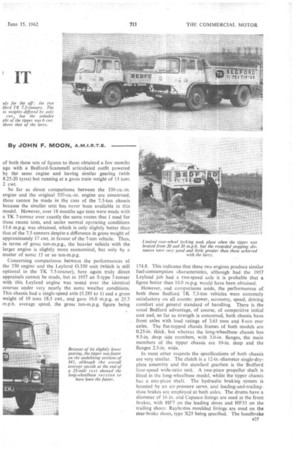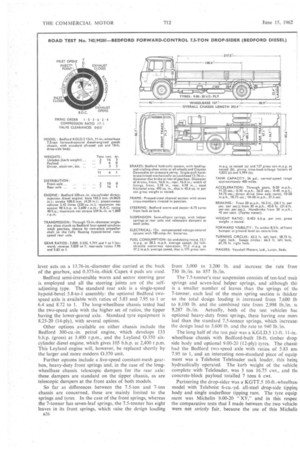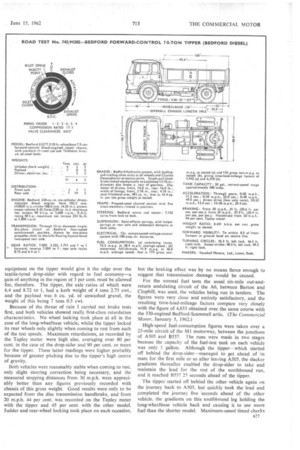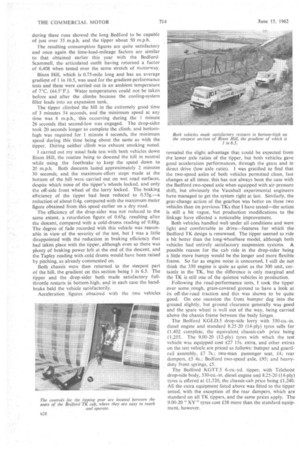THE LONG AND THE SHOR 'IT
Page 58

Page 59

Page 60

Page 61

Page 62

If you've noticed an error in this article please click here to report it so we can fix it.
By JOHN F. MOON, A.M.I.R.T.E. THE chance of conducting parallel road tests on longand short-wheelbase versions of the same basic chassis does not often come along, and is not to be missed whenever it does. Recently such an opportunity came my way, the vehicles in question being Bedford TK 7.5-tonners, both powered by Bedford-built 330-cu.-in. diesel engines, driving through four-speed synchromesh gearboxes and two-speed rear axles. The long-wheelbase model had the high set of axle ratios, and both vehicles had been loaded so that their gross weights were within 0.5 cwt. of each other.
Being tested under identical conditions—one behind the other, in fact—it was possible to make truly direct comparisons between the performances of these two types, and some interesting facts arose. One was that, despite the higher centre of gravity of the short-wheelbase model and therefore the higher weight transference from the rear to the front axle during maximum braking, the tipper took only 2.5 ft. greater distance to stop from 30 m.p.h.—and the braking performance of both models was extremely good.
Also of interest was the fact that the tipper, which had the lower set of axle ratios, was more economical—both under normal road conditions and when driven at continuous full throttle on the motorway. This is not altogether surprising, this characteristic arising from the power to weight ratio: had an engine with, say, 10 or 15 b.h.p. greater output been installed, the model with the higher axle ratio would undoubtedly have been more economical As it was, the axle ratios of the long-wheelbase vehicle were high enough to keep the engine working just that little bit harder than that of the tipper, hence the slightly greater economy of the lower-geared job.
The two sets of fuel consumption figures taken showed also that the tipper could cover an undulating route at a slightly higher average speed without either vehicle exceed
n24 ing a maximum speed of 33 m.p.h., whilst on the motorway there was very little difference in the overall average speeds of the two models—despite an appreciable difference in potential maximum speed—and on the southbound run between the junctions of B557 and A505 the tipper was decidedly faster than the long-wheelbase vehicle because of the steeper climbs on this section of Ml.
Further interesting conclusions can be made from these two tests. For instance, the braking performances were better in both cases than I had previously obtained with a Bedford TK 7-ton model. The braking systems of the 7and 7.5-ton chassis are identical, so this can only be because of the higher wheel loadings and a more advantageous front-rear axle distribution. Also of interest is the comparative closeness of the time-load-mileage factors of the two models under similar conditions, and the closeness of both these sets of figures to those obtained a few months ago with a Bedford-Scammell articulated outfit powered by the same engine and having similar gearing (with 8.25-20 tyres) but running at a gross train weight of 15 tons 2 cwt.
So far as direct comparisons between the 330-cu.-in. engine and the original 300-cu.-in. engine are concerned, these cannot be made in the case of the 7.5-ton chassis because the smaller unit has never been available in this model. However, over 18 months ago tests were made with a TK 7-tonner over exactly the same routes that I used for these recent tests, and under normal operating conditions 15.6 m.p.g. was obtained, which is only slightly better than that of the 7.5-tonners despite a difference in gross weight of approximately 17 cwt, in favour of the 7-ton vehicle. Thus, in terms of gross ton-m.p.g., the heavier vehicle with the larger engine is slightly more economical, but only by a matter of some 15 or so ton-m.p.g.
Concerning comparisons between the performances of the 330 engine and the Leyland 0.350 unit (which is still optional in the TK 7.5-tonner), here again truly direct appraisals cannot be made, but in 1957 an S-type 7-tonner with this Leyland engine was tested over the identical Courses under very nearly the same weather conditions. This chassis had a single-speed axle (5.285 to 1) and a gross weight of 10 tons 18.5 cwt., and gave 16.0 m.p.g. at 25.7 m.p.h. average speed, the gross ton-m.p.g. figure being 174.8, This indicates that these two engines produce similar fuel-consumption characteristics, although had the 1957 Leyland job had a two-speed axle it is probable that a figure better than 16.0 m.p.g. would have been obtained.
However, and comparisons aside, the performances of both these Bedford TK 7.5-ton vehicles were extremely satisfactory on all counts: power, economy, speed, driving comfort and general standard of handling. There is the usual Bedford advantage, of course, of competitive initial cost and, so far as strength is concerned, both chassis have front axles with load ratings of 3.65 tons and 8-ton rear axles. The flat-topped chassis frames of both models are 0.25-in, thick, but whereas the long-wheelbase chassis has 9.5-in, deep side members, with 3.0-in. flanges, the main members of the tipper chassis are 10-in, deep and the flanges 2.5-in. wide.
In most other respects the specifications of both chassis are very similar. The clutch is a 12-in.-diameter single-dryplate assembly and the standard gearbox is the Bedford four-speed wide-ratio unit, A two-piece propeller shaft is fitted in the long-wheelbase model, whilst the tipper chassis has a one-piece shaft. The hydraulic braking system is boosted by an air-pressure servo, and leading-and-trailingshoe brakes are employed at both axles. The drums have a diameter of 16 in. and Capasco linings are used at the front brakes, with HF7 on the leading shoes and HF33 on the trailing shoes: Raybcstos moulded linings are used on the rear-brake shoes, type X25 being specified. The handbrake lever acts on a 13.76-in.-diameter disc carried at the back of the gearbox, and 0.375-in.-thick Capex 4 pads are used.
Bedford semi-irreversible worm and sector steering gear is employed and all the .steering joints are of the selfadjusting type. The standard rear axle is a single-speed hypoid-bevel 5.8-to-1 assembly: the optional Bedford twospeed axle is available with ratios of 5.83 and 7.95 to 1 or 6.4 and 8.72 to I. The long-wheelbase chassis tested had the two-speed axle with the higher set of ratios, the tipper having the lower-geared axle. Standard tyre equipment is 8.25-20 (14-ply), with several options.
Other options available on either chassis include the Bedford 300-cu.-in. petrol engine, which develops 133 h.h.p. (gross) at 3,400 r.p.m., and the Leyland 0.350 sixcylinder diesel engine, which gives 105 b.h.p. at 2,400 r.p.m. This Leyland engine will, however, be replaced shortly by the larger and more modern 0.370 unit.
Further options include a five-speed constant-mesh gearbox, heavy-duty front springs and, in the case of the longwheelbase chassis, telescopic dampers for the rear axle: these dampers are standard on the tipper chassis, as are telescopic dampers at the front axles of both models.
So far as differences between the 7.5-ton and 7-ton chassis are concerned, these are mainly limited to the springs and tyres. In the case of the front springs, whereas the 7-tonner has seven-leaf springs, the 7.5-tonner has eight leaves in its front springs, which raise the design loading from 3,000 to 3,200 lb. and increase the rate fron 730 lb./in. to 857 lb./in.
The 7.5-tonner's rear suspension consists of ten-leaf mai/ springs and seven-leaf helper springs, and although thi; is a smaller number of leaves than the springs of thc 7-tonner, each leaf of the main spring section is thicker so the total design loading is increased from 7,600 lb to 8,100 lb. and the combined rate from 2,998 lb./in. tc 3,287 lb./in. Actually, both of the test vehicles hat optional heavy-duty front springs, these having one mori leaf than the standard 7.5-tonner springs, which increase; the design load to 3,600 lb. and the rate to 940 lb. qn.
The long half of the test pair was a KGLD.5 13-ft. 11-in. wheelbase chassis with Bedford-built 18-ft. timber drop side body and optional 9.00-20 (12-ply) tyres. The chassi had the Bedford two-speed axle with ratios of 5.83 an 7.95 to 1, and an interesting non-standard piece of equip ment was a Telehoist Teleloader sack loader, this beim hydraulically operated. The kerb weight of the vehicle complete with Teleloader, was 3 ton 16.75 cwt., and thi concrete-block payload totalled 7 tons 6 cwt.
Partnering the drop-sider was a KGTT.5 10-ft-wheelbas1 model with Telehoist 6-cu.-vd. all-steel drop-side tippiril body and single underfloor tipping ram. The tyre equip ment was Michelin 9.00-20 " XY," and in this respec the comparative tests that I made between the two vehicle were not strictly fair, because the use of this Michelit equipment on the tipper would give it the edge over the textile-tyred drop-sider with regard to fuel economy-a gain of anything in the region of 5 per cent, must be allowed for, therefore. The tipper, the axle ratios of which were 6.4 and 8.72 to 1, had a kerb weight of 4 tons 2.75 cwt., and the payload was 6 cu. yd. of unwashed gravel, the weight of this being 7 tons 0.5 cwt.
Because of the threat of rain I carried out brake tests first, and both vehicles showed really first-class retardation characteristics. No wheel locking took place at all in the case of the long-wheelbase vehicle, whilst the tipper locked its rear wheels only slightly when coming to rest from each of the test speeds. Maximum retardations, as recorded by the Tapley meter. were high also, averaging over 80 per cent. in the case of the drop-sider and 90 per cent. or more for the tipper. These latter readings were higher probably because of greater pitching due to the tipper's high centre of gravity.
Both vehicles were reasonably stable when coming to rest. only slight steering correction being necessary, and the measured stopping distances from 30 m.p.h. were appreciably better than any figures previously recorded with chassis of this gross weight. Good results were only to be expected from the disc transmission handbrake, and from 20 m.p.h. 44 per cent, was recorded on the Tapley meter with the tipper and 45 per cent, with the other model. Judder and rear-wheel locking took place on each occasion, but the braking effect was by no means fierce enough to suggest that transmission damage would be caused.
For the normal fuel tests the usual six-mile out-andreturn undulating circuit of the A6, between Barton and Clophill, was used, the vehicles being run in tandem. The figures were very close and entirely satisfactory, and the resulting time-load-mileage factors compare very closely with the figure of 4,833 obtained over the same course with the 330-engined Bedford-Scammell artic. (The Commercial Motor, January 5, 1962.)
High-speed fuel-consumption figures were taken over a 23-mile circuit of the Ml motorway, between the junctions of A505 and B557. The runs were made in two stages because the capacity of the fuel-test tank on each vehicle was only 1 gallon. Although the tipper-which started off behind the drop-sider -managed to get ahead of its mate for the first mile or so after leaving A505, the slacker gradients thereafter enabled the drop-sider to take and maintain the lead for the rest of the northbound run, and it reached B557 25 seconds ahead of the tipper.
The tipper started off behind the other vehicle again on the journey back to A505, but quickly took the lead and completed the journey five seconds ahead of the other vehicle, the gradients on this southbound leg holding the long-wheelbase vehicle back and causing it to use more fuel than the shorter model. Maximum-speed timed checks
during these runs showed the long Bedford to be capable of just over 55 m.p.h. and the tipper about. 50 m.p.h.
The resulting consumption figures are quite satisfactory and once again the time-load-mileage factors are similar to that obtained earlier this year with the BedfordScammell, the articulated outfit having returned a factor of 6,408 when tested over the same stretch of motorway.
Bison Hill, which is 0.75-mile long and has an average gradient of 1 in 10.5, was used for the gradient-performance tests and these were carried out in an ambient temperature of 7°C. (44.5'F.). Water temperatures could not be taken before and after the climbs because the cooling-system filler leads into an expansion tank.
The tipper climbed the hill in the extremely good time of 3 minutes 54 seconds, and the minimum speed at any time was 8 m.p.h., this occurring during the 1 minute 26 seconds that second-low was engaged. The drop-sider took 20 seconds longer to complete the climb, and bottomhigh was required for 1 minute 4 seconds, the minimum speed during this time being about the sane as with the tipper. Miring neither climb was exhaust smoking noted.
carried out my usual fade testwith both vehicles down Bison Hill, the routine being to descend the hill in neutral while using the footbrake to keep the speed down to 20 m.p.h. Both descents lasted approximately 2 minutes 30 seconds, and the maximum-effort stops made at the bottom of the .hili were carried out on wet road surfaces, despite which none of the tipper's wheels locked, and only the off-side front wheel of the lorry locked. The braking efficiency of the tipper had been reduced to 0.55g.—a reduction of about 0.4g. compared with the maximum meter figure obtained from this speed earlier on a dry road.
The efficiency of the drop-sider was not reduced to the same extent, a retardation figure of 0.65g. resulting after the descent, compared with a cold-drums reading of 0.88g. The degree of fade recorded with this vehicle was reasonable in view of the severity of the test, but 1 was a little disappointed with the reduction in braking efficiency that had taken place with the tipper, although even so there was plenty of braking power left at the end of the descent, and the Tapley reading with cold drums would have been raised by pitching, as already commented on.
Both chassis were then returned to the steepest part of the hill; the gradient on this section being 1 in 6.5. The tipper and the .drop-sider both made satisfactory fullthrottle restarts in bottom-high, and in each case the handbrake held the vehicle satisfactorily.
Acceleration figures obtained with the two vehicles revealed the slight • advantage that could be expected from the lower axle ratios of the tipper, but both vehicles gave good acceleration performances, through the gears and in direct drive (low axle ratio). I was gratified to find that the two-speed axles of both vehicles permitted clean, fast changes at all times: this has not always been the case with the Bedford two-speed axle when equipped with air-pressure shift, but obviously the Vauxhall experimental engineers have managed to get the system right at last. Similarly, the gear-change action of the gearbox was better on these two vehicles than On previous TKs that I have tested—the action is still a bit vague, but production modifications to the linkage have effected a noticeable improvement.
Both vehicles handled well under all conditions and were light and comfortable to drive—features for which the Bedford TK design is renowned The tipper seemed to ride a bit better than the long-wheelbase model, although both vehicles had entirely satisfactory suspension systems. A possible reason for the cab ride in the drop-sider being a little more bumpy would be the longer and more flexible frame. So far as engine noise is concerned, I still do not think the 330 engine is quite as quiet as the 300 unit, certainly in the TK, but the difference is only marginal and the TK is still one of the quietest vehicles in production.
Following the road-performance tests, I took the tipper over some rough, grass-covered ground to have a look at its off-the-road traction and this was shown to be quite good. On one oecasion the front bumper dug into the ground slightly, but ground clearance generally was good and the spare wheel is well out of the way, being carried above the chassis frame between the body hinges.
The Bedford KGLD.5 drop-side lorry with 330-cu.-in. diesel engine and standard 8.25-20 (14-ply) tyres sells for £1,402 complete, the equivalent chassis-cab price being £1,255. The 9.00-20 (12-ply) tyres with which the test vehicle was equipped cost £27 15s. extra, and other extras on the test vehicle are priced as follows: bumper and guardrail assembly, £7 7s.; two-man passenger seat, £4; rear dampers, £5 4s.; Bedford two-speed axle, £95; and heavyduty front springs, £5:
The Bedford KGTT.5 6-cu.-yd. tipper, with Telehoist drop-side body, 330-cu.-in. diesel.engine and 8.25-20 (14-ply) tyres is offered at £1,520, the chassis-cab price being £1,240. All the extra equipment listed above was fitted to the tipper tested, with the exception of the rear dampers, which are standard on all TK tippers, and the same prices apply. The 9.00-20 " XY " tyres cost £38 more than the standard equipment, however.




















































































































